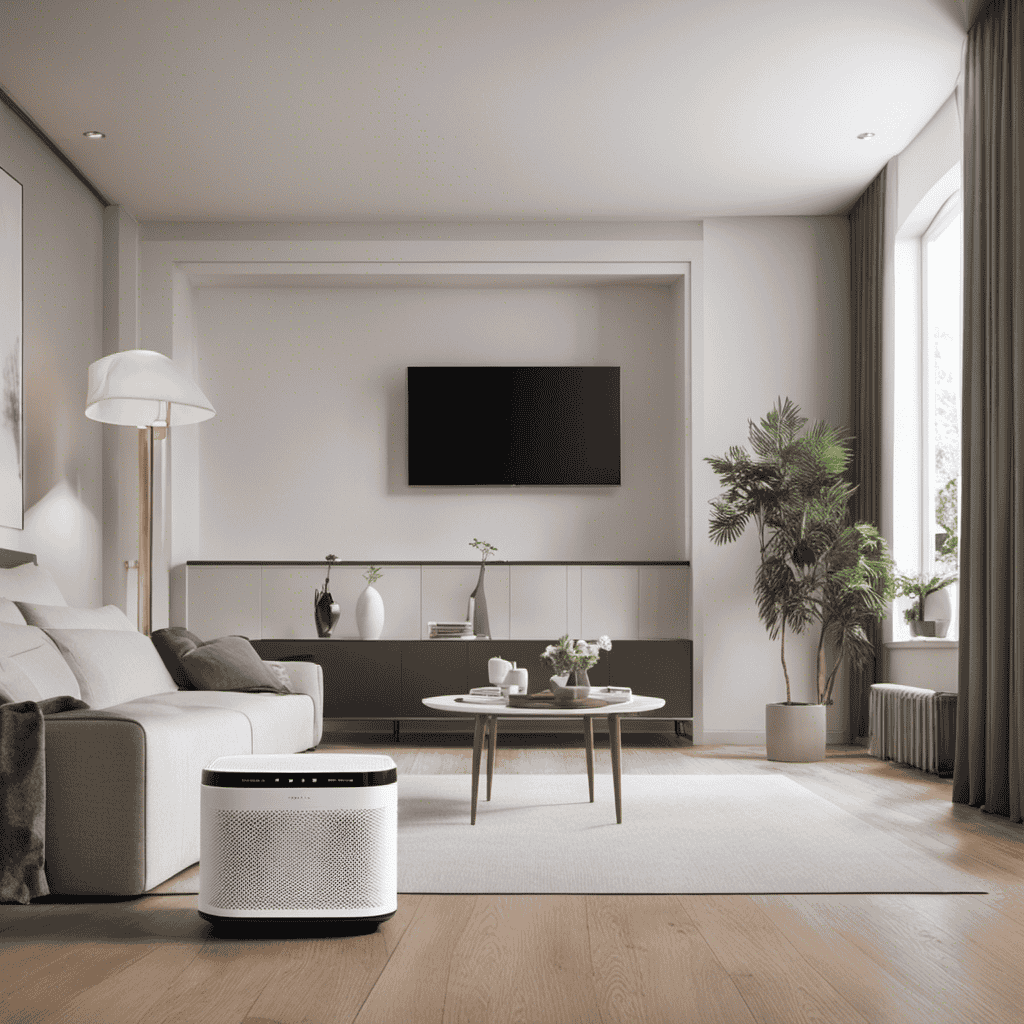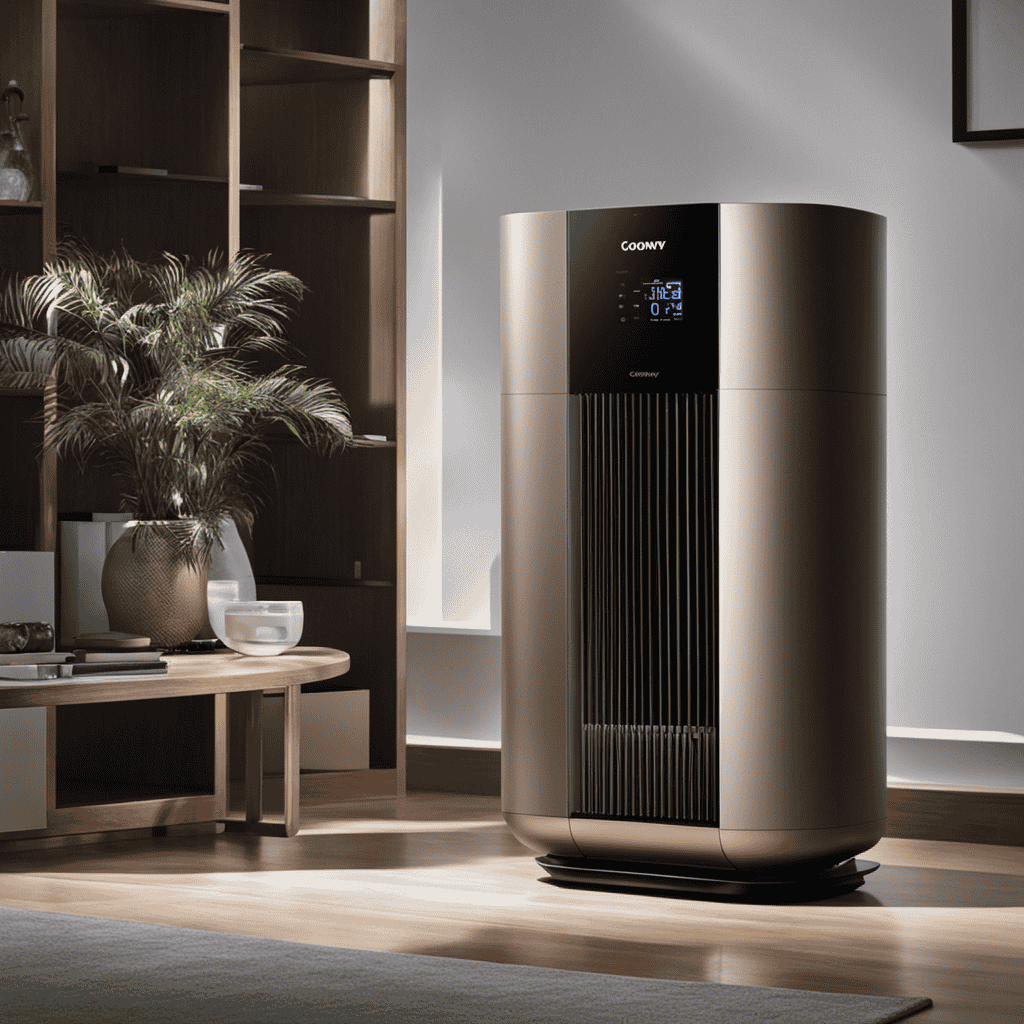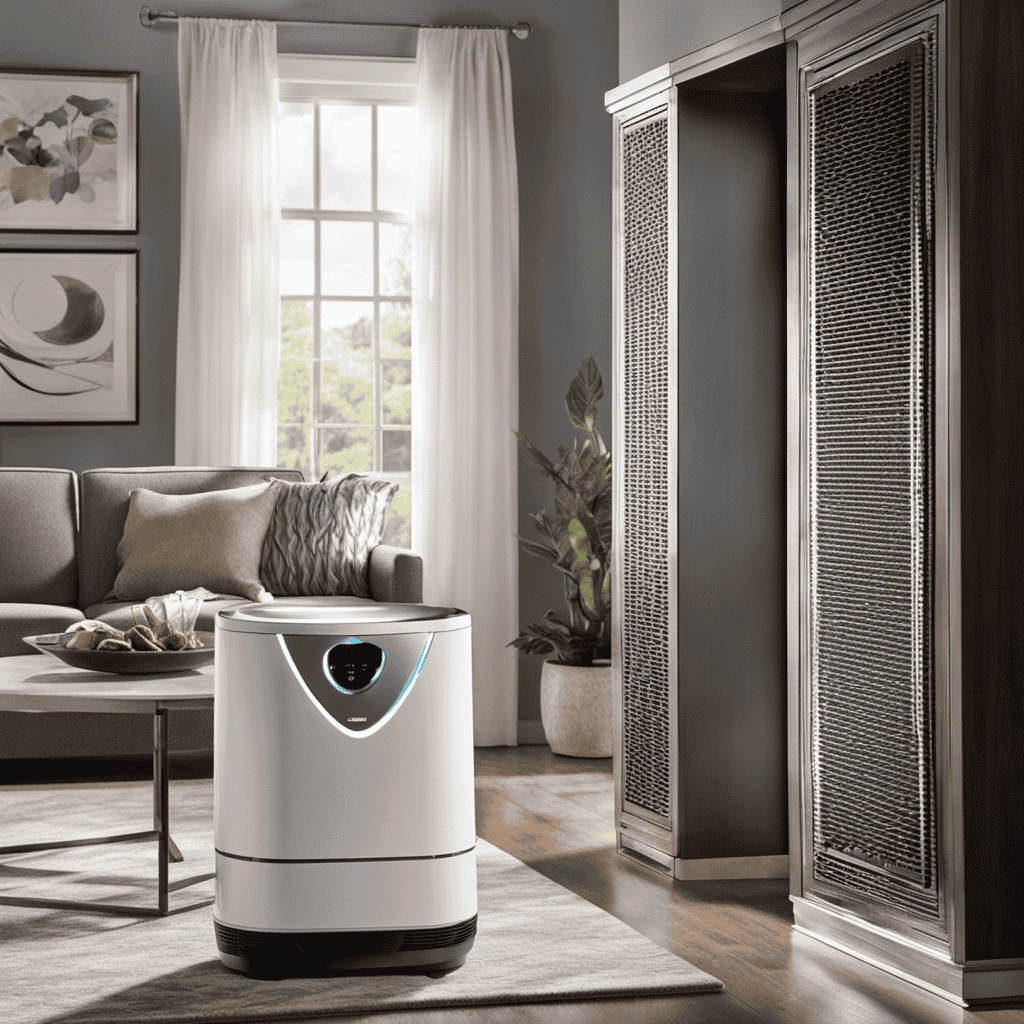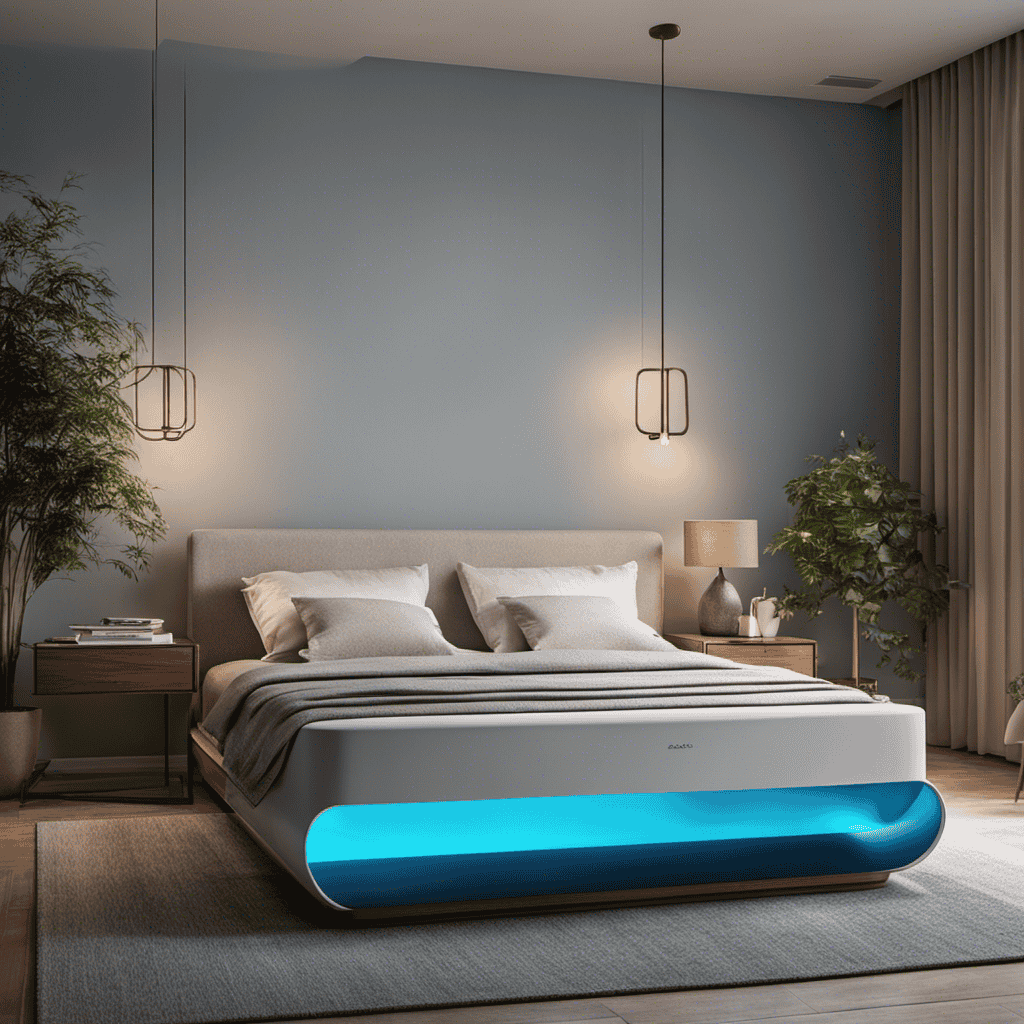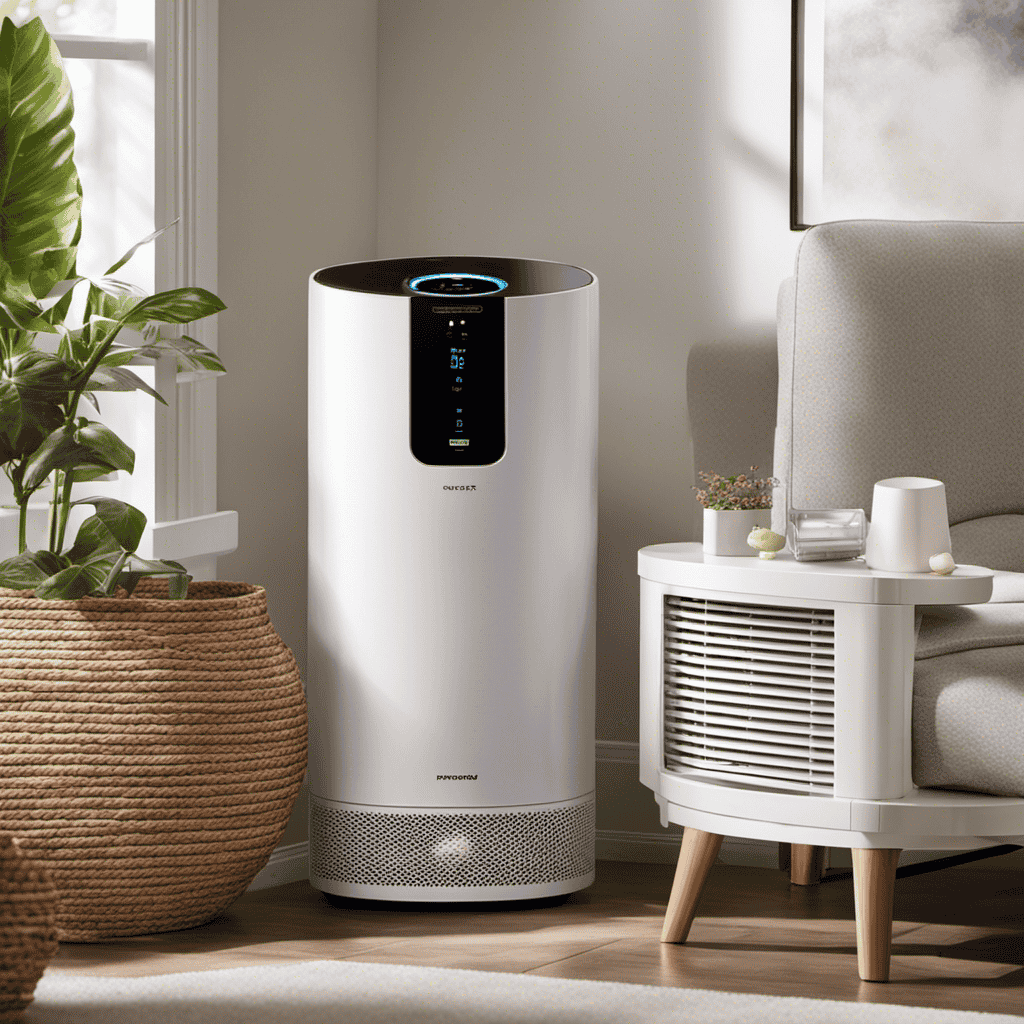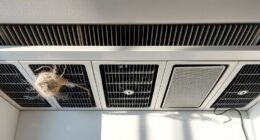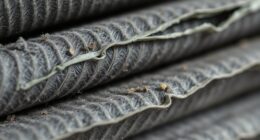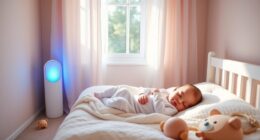Have you ever pondered about the functioning of air purifiers?
Well, let me shed some light on the subject.
Air purifiers are equipped with key components that work together to improve the quality of the air you breathe.
By using advanced filtration technology, such as HEPA filters and activated carbon filters, these devices effectively remove harmful particles and odors from the air.
Additionally, UV-C light technology and electrostatic precipitators offer alternative methods of air purification.
Join me as we delve into the inner workings of air purifiers and discover the importance of proper maintenance.
Key Takeaways
- Air purifiers work by using filters to trap and remove airborne particles such as dust, pollen, and pet dander.
- The fan in an air purifier circulates the air in the room, allowing it to pass through the filter and remove impurities.
- Sensors in air purifiers detect the level of pollutants in the air and adjust the fan speed accordingly for optimal purification.
- HEPA and activated carbon filtration are key technologies used in air purifiers to remove particles as small as 0.3 microns and adsorb gaseous pollutants and odors, respectively.
Key Components of an Air Purifier
The key components of an air purifier include a filter, fan, and sensors.
The filter is the most important part of the air purifier as it traps and removes airborne particles such as dust, pollen, and pet dander. It is crucial to regularly maintain the filter by cleaning or replacing it to ensure optimal performance.
The fan helps to circulate the air in the room, allowing it to pass through the filter and removing impurities.
The sensors in the air purifier detect the level of pollutants in the air and adjust the fan speed accordingly.
There are various air purification techniques used in air purifiers, such as HEPA filtration, activated carbon filtration, and UV germicidal irradiation, which work together to effectively purify the air and improve indoor air quality.
Understanding Air Filtration Technology
When it comes to air filtration technology, understanding the mechanisms behind filtration is crucial. Filtration mechanisms are responsible for trapping and removing harmful particles from the air, ensuring cleaner and healthier indoor environments.
In this discussion, we will delve into the different types of filtration mechanisms and explore the key benefits they provide. These benefits include improved air quality, reduced allergies, and enhanced respiratory health.
Filtration Mechanisms Explained
To understand how an air purifier works, you need to know about its filtration mechanisms. Air purifiers employ various methods to remove harmful pollutants from the air. Here are three key filtration mechanisms used in air purifiers:
-
Mechanical filtration: This process involves capturing particles as air passes through a filter. High-efficiency particulate air (HEPA) filters are commonly used in air purifiers for their ability to trap particles as small as 0.3 microns, including dust, pollen, pet dander, and mold spores.
-
Activated carbon filtration: This mechanism utilizes a porous material, typically activated carbon, to adsorb gaseous pollutants such as volatile organic compounds (VOCs), odors, and chemicals. The carbon’s large surface area traps and removes these contaminants from the air.
-
Electrostatic precipitation: This mechanism relies on an electrostatic charge to attract and capture particles. An ionizer or electrostatic precipitator generates negative ions, which attach to airborne particles, causing them to become positively charged and stick to oppositely charged plates or filters.
Understanding these filtration mechanisms is essential for effective air purifier maintenance and ensuring cleaner indoor air by removing various types of air pollutants.
Key Benefits of Filtration
One of the key benefits of filtration is that it helps improve the quality of the air I breathe indoors.
Air purifiers are highly effective in removing harmful particles and pollutants from the air, ensuring a healthier living environment.
Research has shown that air purifiers can reduce the concentration of airborne allergens, such as dust mites, pollen, and pet dander, providing relief for individuals suffering from allergies or asthma.
Moreover, air purifiers can also help eliminate volatile organic compounds (VOCs) and other harmful chemicals, improving overall indoor air quality.
This is particularly beneficial for people with respiratory conditions or weakened immune systems.
The Role of Filters in Air Purification
You can’t ignore the importance of filters when it comes to air purification. Filters play a crucial role in removing pollutants and improving indoor air quality. Here are three reasons why filters are integral to the air purification process:
-
Effective Particle Removal: Filters are designed to capture and trap harmful particles such as dust, pollen, pet dander, and mold spores. Regular maintenance of these filters ensures their efficiency in removing these pollutants and preventing them from circulating in the air.
-
Enhanced Health and Well-being: High-quality filters can significantly impact the air quality in your home or office. Clean air free from pollutants can help reduce respiratory issues, allergies, and asthma symptoms. Regularly replacing or cleaning filters ensures that they continue to provide optimal air purification, thus promoting a healthy environment.
-
Increased Longevity of Air Purifiers: Filters act as a barrier, preventing particles from clogging the internal components of the air purifier. Regular maintenance, such as cleaning or replacing filters, ensures that your air purifier operates at its best, prolonging its lifespan and maintaining its effectiveness in purifying the air.
How Does HEPA Filtering Work
Understanding how HEPA filtering functions is essential for comprehending the effectiveness of air purifiers in removing harmful particles from the air. HEPA, or High Efficiency Particulate Air, filters are designed to capture particles as small as 0.3 microns with an efficiency rating of 99.97%. This means that for every 10,000 particles passing through the filter, only three particles are allowed to escape. To illustrate the effectiveness of HEPA filters, consider the following table:
| Particle Size | HEPA Filter Efficiency |
|---|---|
| 0.3 microns | 99.97% |
| 1 micron | 99.97% |
| 2.5 microns | 99.97% |
| 10 microns | 99.97% |
As shown in the table, HEPA filters are highly efficient in filtering particles of various sizes. This efficiency is achieved through a combination of three mechanisms: interception, impaction, and diffusion. Interception occurs when particles collide with filter fibers, impaction happens when particles are unable to change direction and become embedded in the filter, and diffusion refers to the random movement of particles that causes them to collide with filter fibers. These mechanisms work together to ensure that harmful particles are effectively trapped and removed from the air. With a solid understanding of HEPA filter efficiency and particle size filtration, we can now explore the benefits of activated carbon filters.
Exploring Activated Carbon Filters
Activated carbon filters effectively remove odors and gases from the air by adsorbing the particles onto their porous surface. The process of adsorption involves the attraction and binding of molecules to the surface of the activated carbon material.
Here are three key features of activated carbon filters:
-
High adsorption capacity: Activated carbon has a large surface area due to its porous structure, allowing it to adsorb a significant amount of pollutants. This makes it highly effective in removing volatile organic compounds (VOCs) from the air.
-
Chemical filtration: Activated carbon filters are designed to target specific gases and odors. The activated carbon material is treated with various chemicals to enhance its adsorption capabilities for specific pollutants.
-
Long-lasting performance: Activated carbon filters have a longer lifespan compared to other types of filters. They can effectively remove pollutants for an extended period before needing replacement.
With activated carbon filters effectively removing odors and gases, let’s now explore the benefits of UV-C light technology in air purification.
The Benefits of UV-C Light Technology
Get ready to discover how UV-C light technology can enhance the air purification process and provide additional benefits to your living space. UV-C light technology utilizes ultraviolet light with a wavelength between 200 and 280 nanometers. This type of light has the ability to destroy the genetic material of microorganisms, such as bacteria and viruses, rendering them unable to reproduce and infect the air. The disinfection benefits of UV-C light technology are well-documented and widely recognized. It is a highly effective method for eliminating harmful pathogens from the air, ensuring cleaner and healthier indoor environments. Additionally, UV-C light technology is environmentally friendly and does not produce any harmful byproducts. It is a safe and efficient way to improve the air quality in your home or office.
| UV-C Light Technology Benefits | ||
|---|---|---|
| Disinfection | Efficiency | Environmentally Friendly |
| Destroys harmful pathogens | Highly effective method | No harmful byproducts |
| Improves indoor air quality | Ensures cleaner environments | Safe and efficient |
| Reduces the risk of infections | Enhances the air purification process | Promotes a healthier living space |
UV-C light technology is just one of the many air purification methods available. However, its unique ability to effectively disinfect the air sets it apart from other options. Now, let’s explore another alternative air purification method called electrostatic precipitators.
Electrostatic Precipitators: An Alternative Air Purification Method
Electrostatic precipitators are an alternative method for purifying the air without using UV-C light technology. These devices use ionization technology to remove harmful particles from the air.
Here are three key features of electrostatic precipitators:
-
Ionization: Electrostatic precipitators work by ionizing the air, creating a negative charge on the particles. The charged particles are then attracted to positively charged plates or collector plates within the device.
-
Collection: As the particles are attracted to the collector plates, they stick to the surface and are effectively removed from the air. This process helps to eliminate pollutants such as dust, smoke, pollen, and even some bacteria and viruses.
-
Efficiency: Electrostatic precipitators are known for their high efficiency in removing particles from the air. They can capture particles as small as 0.01 microns, making them effective in purifying the air in various environments.
Overall, electrostatic precipitators offer an effective alternative method for air purification, utilizing ionization technology to provide clean and healthy air.
The Importance of Proper Maintenance for Air Purifiers
Regular cleaning is crucial for maintaining the performance and longevity of air purifiers. By following some simple cleaning tips, such as regularly wiping down the exterior and replacing filters according to the manufacturer’s instructions, you can ensure that your air purifier continues to effectively remove pollutants from the air.
Not only does regular cleaning improve the overall air quality in your space, but it also extends the lifespan of the air purifier, providing long-term benefits for both your health and your investment.
Regular Cleaning Tips
To keep your air purifier running efficiently, make sure you’re regularly cleaning the filters. Cleaning the filters is essential to maintain the performance and longevity of your air purifier. Here are three cleaning techniques that you should incorporate into your maintenance schedule:
-
Vacuuming: Use a vacuum cleaner with a brush attachment to gently remove dust and debris from the surface of the filters. This will help to improve the airflow and prevent clogging.
-
Washing: Some air purifier filters are washable. Follow the manufacturer’s instructions to remove the filters and wash them with mild soap and water. Allow them to dry completely before reinserting them into the air purifier.
-
Replacement: In some cases, the filters may not be washable and need to be replaced. Check the maintenance schedule provided by the manufacturer to determine when it’s time to replace the filters. Regularly replacing the filters ensures optimal performance and clean air in your home.
Long-Term Performance Benefits
By regularly cleaning and maintaining my air purifier, I can enjoy long-term performance benefits such as improved air quality and a healthier living environment.
Not only does cleaning the filters and removing dust and debris from the unit help to maintain its efficiency, but it also ensures that the air purifier continues to operate optimally. This leads to better air quality, as the purifier is able to effectively remove pollutants and allergens from the air.
Additionally, regular maintenance can help to reduce the energy consumption of the air purifier, making it more cost-effective and environmentally friendly.
It is also important to note that proper maintenance can help to keep noise levels to a minimum, allowing for a quieter and more peaceful living space.
Frequently Asked Questions
Are Air Purifiers Effective in Removing Viruses and Bacteria From the Air?
Yes, air purifiers are effective in removing viruses and bacteria from the air. Studies have shown that they can reduce the transmission of COVID-19 and are commonly used in hospitals for their effectiveness in improving air quality and reducing the spread of infections.
How Often Do I Need to Replace the Filters in an Air Purifier?
When it comes to filter replacement, it’s crucial to stick to a strict maintenance schedule. Neglecting this could lead to decreased efficiency and compromised air quality. Stay on top of it!
Can an Air Purifier Help Reduce Allergens Like Pollen and Pet Dander?
Yes, an air purifier can help reduce allergens like pollen and pet dander. It filters the air, trapping these particles and preventing them from circulating in your home. Regular air purifier maintenance ensures optimal performance and benefits.
What Is the Noise Level of an Air Purifier?
The noise level of my air purifier is an important consideration for me. I want to ensure that it operates quietly, allowing me to enjoy clean air without any disruptions.
Can an Air Purifier Remove Odors From the Air, Such as Cooking Smells or Cigarette Smoke?
Yes, an air purifier can remove odors from the air, including cooking smells and cigarette smoke. It works by using filters to capture and trap particles and pollutants, providing clean and fresh air.
Is the Levoit Air Purifier More Effective Than Other Air Purifiers?
When comparing air purifiers, the effectiveness of the Levoit air purifier functionality stands out. Its advanced technology ensures efficient removal of airborne pollutants, dust, and allergens, providing cleaner and fresher air. Users have reported significant improvement in air quality, making it a top choice for indoor air purification.
Conclusion
As I conclude my exploration of how air purifiers work, I am struck by the symphony of components working together to create clean and fresh air.
Like a conductor leading an orchestra, the filters, technology, and maintenance all play their part in harmonizing the air purification process.
From the HEPA filters capturing microscopic particles to the activated carbon filters eliminating odors, each element contributes to the symphony of clean air.
With proper maintenance, these purifiers will continue to perform their melody of purity, ensuring a healthier and more breathable environment for all.
